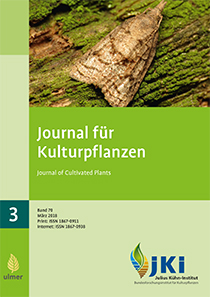Light microscopic studies on the development of <em>Beauveria bassiana</em> and other putative endophytes in leaf tissues
DOI:
https://doi.org/10.5073/JKI.2018.03.02Keywords:
Fungal endophytes, entomopathogenic fungi, biocontrol, Metarhizium anisopliae, Chaetomium globosum, Isaria fumosoroseaAbstract
The study involved six test fungi previously recorded in the literature as being endophytes (Beauveria bassiana, Metarhizium anisopliae, Isaria fumosorosea, Trichoderma harzianum, Fusarium proliferatum, Chaetomium globosum), two plant pathogenic fungi (Ascochyta fabae, Plenodomus lingam) and four host plants (Vicia faba, Brassica napus, Phaseolus vulgaris, Zea mays). Aerial conidia, blastospores, or ascospores, respectively were applied to leaf surfaces by spraying or by infiltrating spore suspensions through stomata directly into the leaves. Observations using light microscopy showed that the test fungi germinated on the leaf surface but did not enter actively into the leaves. Within the leaves, germination of spores and growth of hyphae appeared to depend on the presence of damaged plant tissue. Various host reactions such as browning of epidermal cells and formation of papillae were observed. Colonization of healthy leaves by the test fungi in a manner similar to the pathogens A. fabae (on Faba bean) and P. lingam (on oilseed rape) was not observed. Spore germination and hyphal growth commenced when inoculated leaves were placed on agar medium. The results indicate that the test fungi possessed a saprotrophic rather than an endophytic life style when associated with leaf tissue of the studied hosts.
Published
Issue
Section
License
The content of the journal is licensed under the Creative Commons Attribution 4.0 License. Any user is free to share and adapt (remix, transform, build upon) the content as long as the original publication is attributed (authors, title, year, journal, issue, pages).
The copyright of the published work remains with the authors. The authors grant the Journal of Cultivated Plants, the Julius Kühn-Institut and the OpenAgrar repository the non-exclusive right to distribute and exploit the work.







